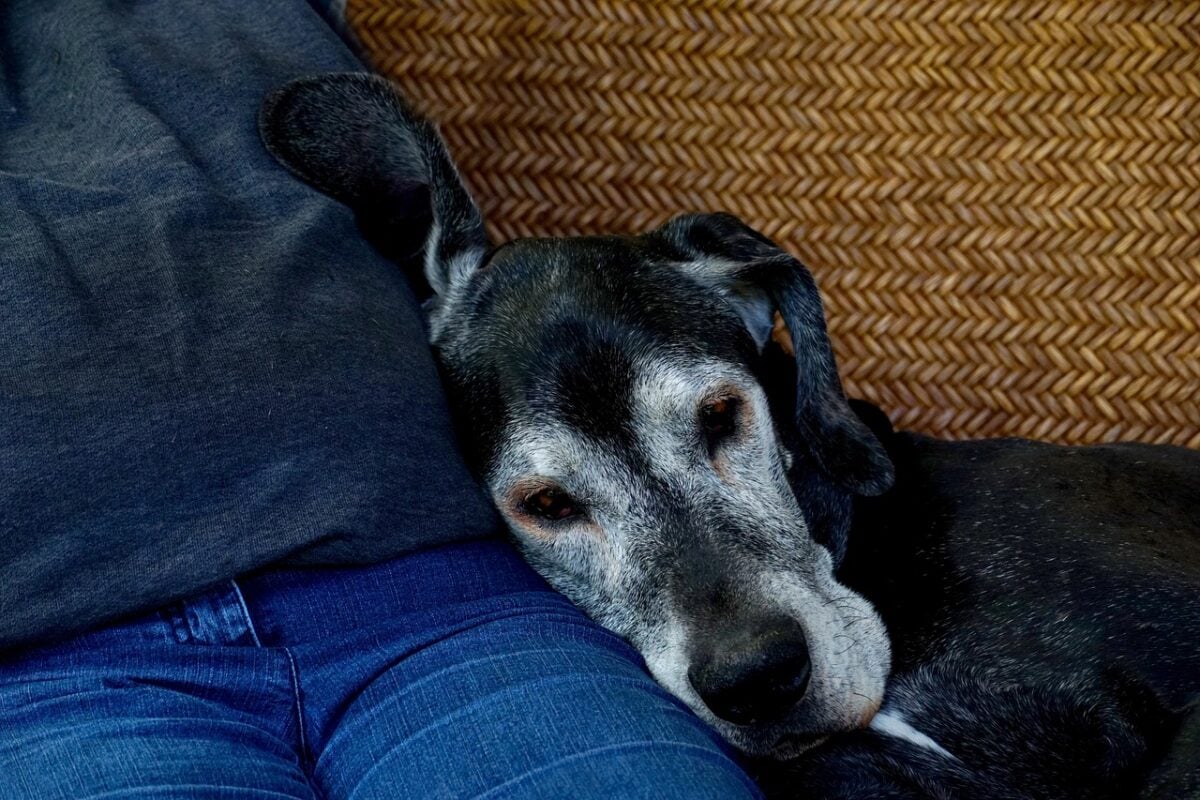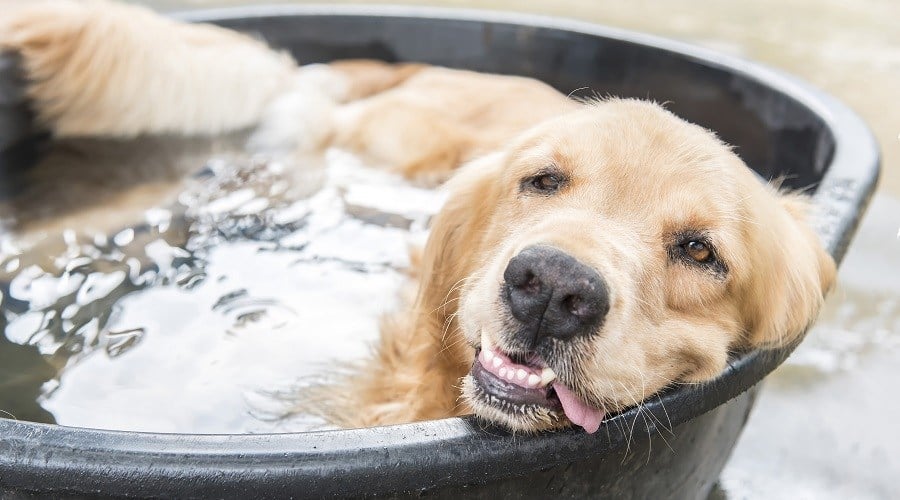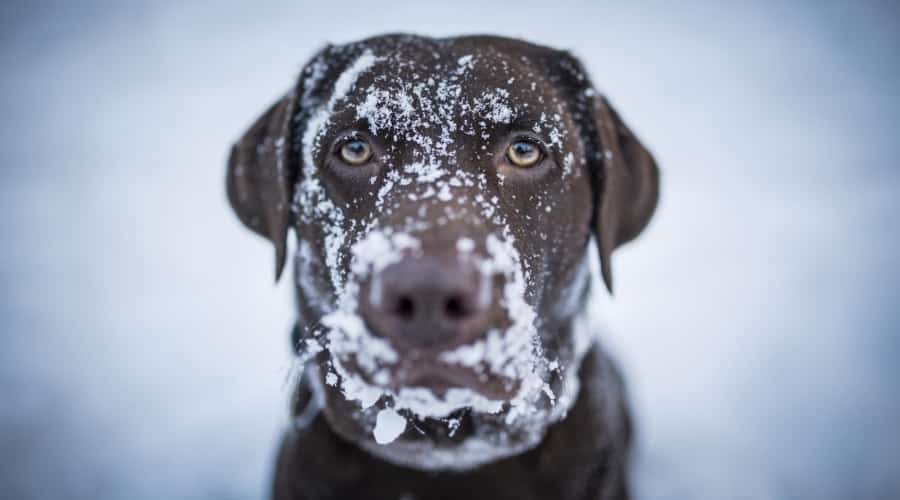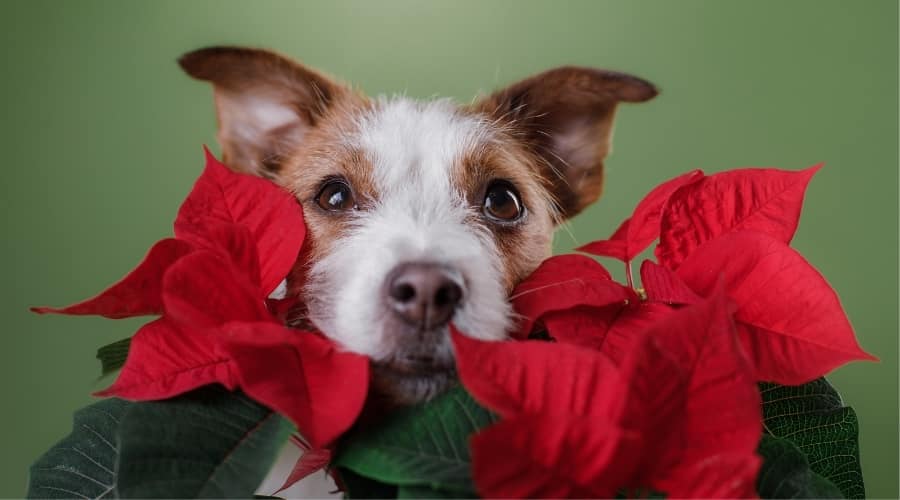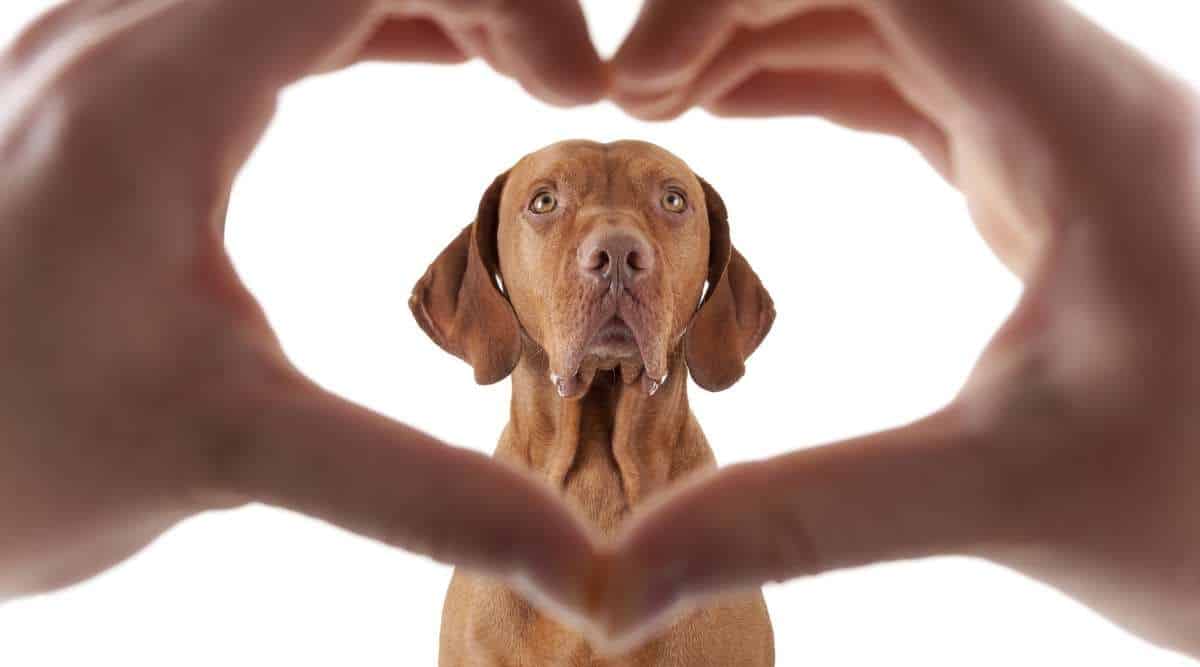How To Deal With The Death of a Dog & Why It Hurts More Than You Ever Expected
When you purchase through links on our site, we may earn a commission. Here’s how it works.
The leash still hangs by the door. The bowl’s untouched. And somehow, the silence feels louder than it ever did before. Losing a dog isn’t “just losing a pet”; it’s losing a heartbeat that matched yours.
Table of Contents
Here’s why it hurts more than you ever expected and how to start healing when your world feels smaller without them.
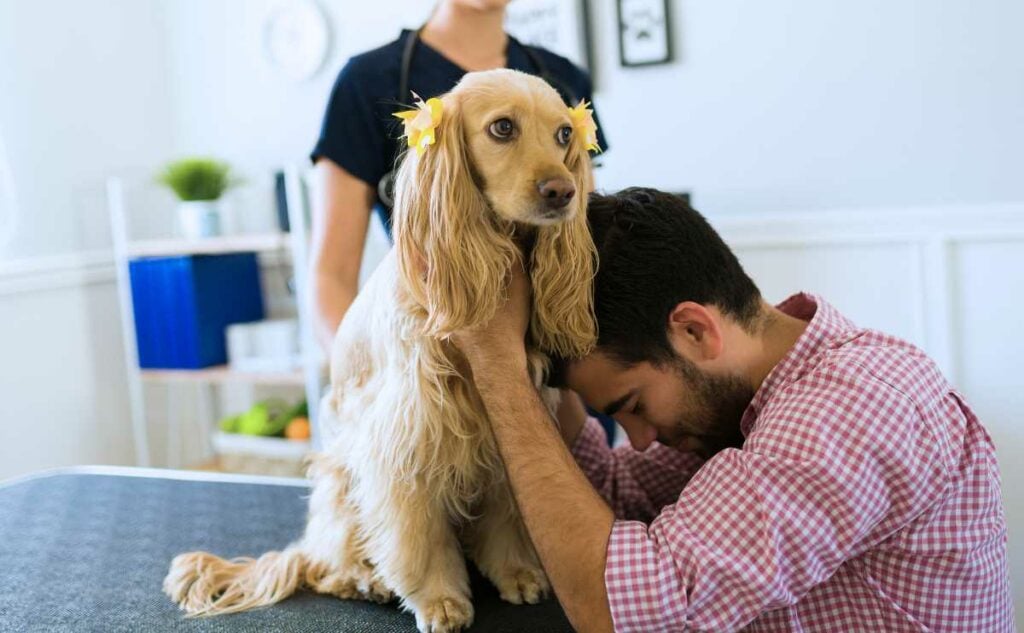
Why Losing a Dog Hurts So Much
Dogs don’t just live with us; they sync with us. They were the first “hello” in the morning, the shadow that followed you from room to room, the calming presence after a hard day. When that’s gone, it leaves more than a void. It disrupts everything familiar.
Your body literally releases oxytocin, the same bonding hormone shared between parents and children, every time you look into your dog’s eyes. That’s why their tail wag calms you, why their presence feels like home.
Many people feel ashamed of their grief, especially if others minimize it. But mourning a dog is not just valid, it’s deeply human. Allow yourself to feel it fully. You are not being dramatic. You are being honest with your heart, your memories, and the place your dog still holds inside you.
The Science of Pet Grief: Why It Feels Like Losing Family
You’re not imagining it, your brain really does grieve a dog the same way it grieves a person.
When you lose them, the limbic system, the part that stores emotional bonds, lights up just like it would after human loss.
The body releases stress hormones such as cortisol, while dopamine and oxytocin levels crash. That mix creates the physical ache, the fog, the sudden tears that come out of nowhere.
Research supports the idea that the grief and loss of a pet can mirror the emotional toll of losing a human loved one. In short, your body thinks a loved one has disappeared, and it’s right.
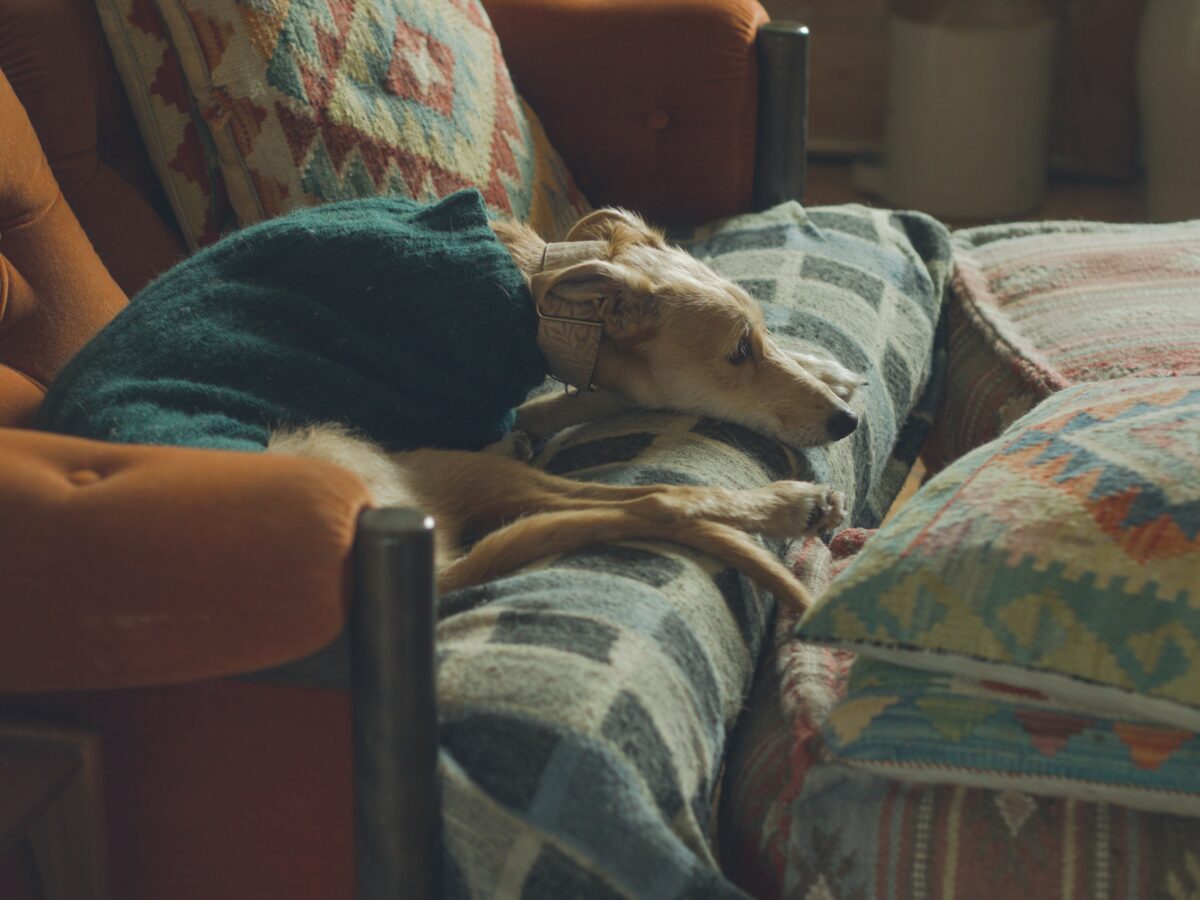
Dogs aren’t just companions; they’re consistent sensory patterns in your day: footsteps, smells, eye contact, and sound. When every one of those vanishes, your brain keeps searching for them, replaying routines that no longer exist.
That’s why you catch yourself pausing before pouring kibble or hearing phantom paws on the floor. It’s not a weakness. It’s not “just a pet.” So if your chest feels heavy or your sleep won’t come, you’re not broken. You’re bonded.
Understanding this biology matters because it replaces self-blame with self-compassion. You’re not “too sensitive.” You’re human. Knowing that can turn guilt into grace while you learn how to deal with the death of a dog, one small moment at a time.
Knowing When It’s Time to Say Goodbye
One of the most heart-wrenching decisions you’ll ever face is whether, and when, to put your dog down.
Most people describe it as a moment when the love that once said “stay” quietly starts whispering “let go.” It doesn’t mean you’ve stopped caring; it means you care enough to put their comfort before your own heartbreak.
Veterinarians often suggest asking three questions:
- Is your dog in chronic pain with no relief?
- Are they no longer eating, playing, or engaging with you?
- Do good days no longer outnumber the bad?

These are painful questions, but necessary ones. Talk with your vet. Talk with your family. But most importantly, trust your bond, because you know your dog better than anyone.
The American Veterinary Medical Association (AVMA) notes that peaceful euthanasia can be an act of mercy that prevents suffering. Choosing release over suffering doesn’t erase the bond; it honors it.
This, too, is how you deal with the death of a dog, with courage, tenderness, and the same devotion they gave you every day.
Need More Guidance? Read our articles that explore When To Put A Dog Down and Dog Euthanasia: What To Expect & How To Prepare.
Do Dogs Know They’re Dying?
It’s a question almost every dog parent asks, and one that tugs at the heart. While science can’t give a simple yes or no, many veterinarians and behaviorists believe dogs sense when their bodies are shutting down. They may not understand the concept of death, but they often recognize change.
In their final days, some dogs grow unusually quiet, spend more time alone, or seek your touch more often. Others retreat to favorite corners or insist on sleeping beside you.
It’s also common for appetite, breathing, or movement patterns to shift as the body begins to tire. None of this is a sign of giving up; it’s simply nature’s gentle slowing.
What One End-of-Life Veterinarian Wants You to Know
In a podcast interview on Your Vet Wants You to Know, Dr. Mary Gardner explained:
There are many people who are adamantly against euthanasia, but they are also adamantly against the pet suffering. You’re not always present for natural passing… I always say that I’m not ending life. I’m ending the dying process. They’re already dying. If we could make sure that they die well, then that would help with some of the regret.
– Dr. Gardner, DVM, Your Vet Wants You to Know Podcast – Hospice and End of Life
She shares that her pets she personally mourns the most are the ones who passed when she wasn’t there to say goodbye, reminding us that being present matters more than perfection.
The most healing thing you can do is stay present. Talk softly. Keep familiar scents and blankets nearby. Your calm presence signals safety, and that’s what they want most in their final stretch.
Quick Takeaway: Dogs may not know they’re dying, but they feel your love to the very last heartbeat. Your calm presence tells them everything they need to know: they’re safe.
Before Goodbye: Little Ways to Hold On While You Still Can
If your dog’s time is drawing near, every small moment suddenly feels like a countdown. The sound of their paws, the way they nudge your hand, the look that says they still know you’re theirs. The time before goodbye can be heartbreaking, but it can also be deeply meaningful.
Grief often starts before loss; psychologists call it anticipatory grief. It’s love trying to stretch time just a little longer. Instead of fighting it, let yourself lean into it.
Quick Takeaway: Anticipatory grief is love refusing to rush goodbye. The small rituals you create now become the memories that help you heal later.
Keepsakes That Help You Heal
Creating keepsakes during your dog’s final days can be an act of love and healing. These small, tangible reminders can help anchor your memories once they’re gone. These aren’t about clinging to sadness; they’re about saving a little piece of joy.
Here are a few simple, meaningful ways to capture the love you built:
- Memory box – Start gathering their favorite toy, collar, or blanket. Write a note to your future self to include inside, including your favorite memories and photos.
- Keepsake jewelry – Some jewelers can turn your pet’s nose print, hair, or ashes into a pendant, bracelet, or keychain.
- Paw or nose print kit – Gently press their paw into clay or ink to make a lasting imprint. These are available in craft stores or online as full memorial kits.
- Photo session at home – Hire a pet photographer specializing in end-of-life sessions. These aren’t posed, they’re intimate snapshots of love in motion. Or set up your own photo session.
- Record their bark or whine – Capture the sound of their voice. It may feel too hard now, but hearing it again later can offer surprising comfort.
You don’t have to do all of these. Even one gesture, made with intention, can become a touchstone of remembrance. It can help you reconnect with gratitude instead of only pain. One day, you’ll open that memory box, touch that paw print, and feel not just loss, but warmth.
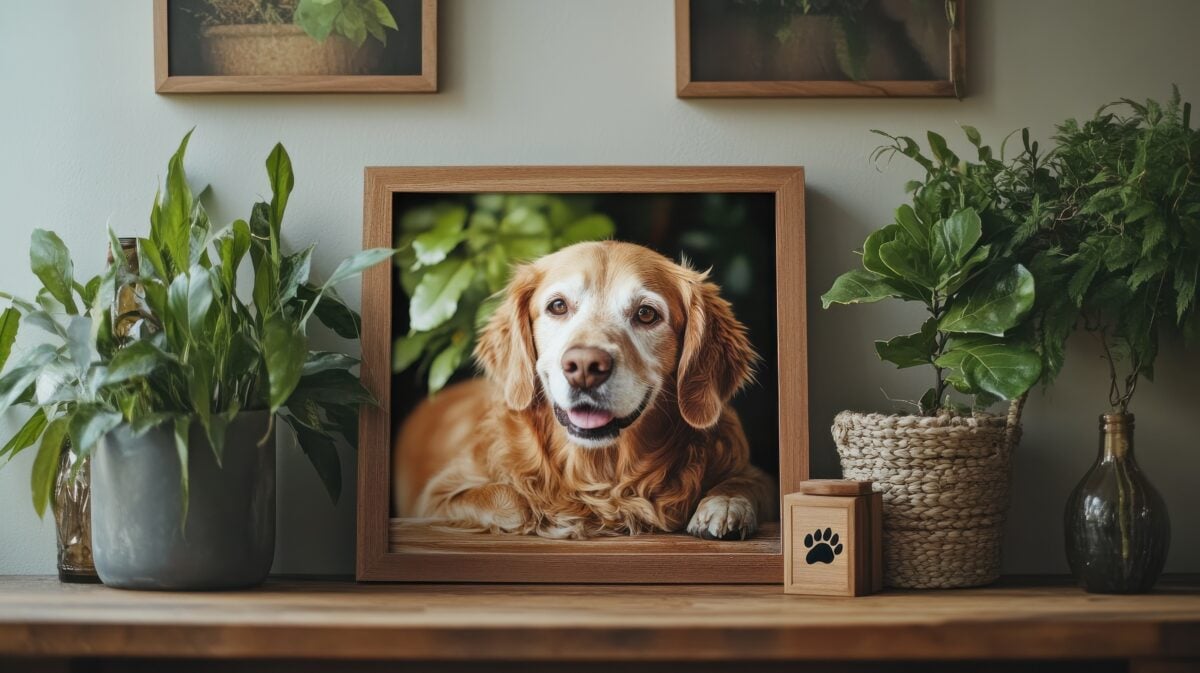
5 Things To Do Right After Your Dog Dies
When the moment finally comes, time seems to stop. The air feels heavy. The world feels wrong. And yet, there are still things that need doing, and that’s the hardest part of all.
If you’re facing those first few hours, here’s what to do when you can barely think straight:
- Call your veterinarian or local emergency clinic. They can walk you through cremation, burial, or memorial options and handle transportation if needed.
- Wrap your dog in a favorite blanket and place them in a cool, quiet space if you need a little time before arrangements.
- Reach out for help. Call a friend, neighbor, or family member who understands. Don’t try to handle everything alone.
- Take a photo if it brings you peace, not pain. Some owners find it grounding later to have a final image of love and stillness.
- If you’re alone and struggling, contact a pet loss support line, like the Tufts Pet Loss Support Hotline.
There’s no right way to react. Some people feel numb, some collapse, and some go straight into cleaning, making calls, or folding blankets because it’s all they can control. However you respond, it’s okay.
What matters most right now is gentleness. Let yourself pause. Breathe. This is the moment your heart begins learning to live around the empty space.
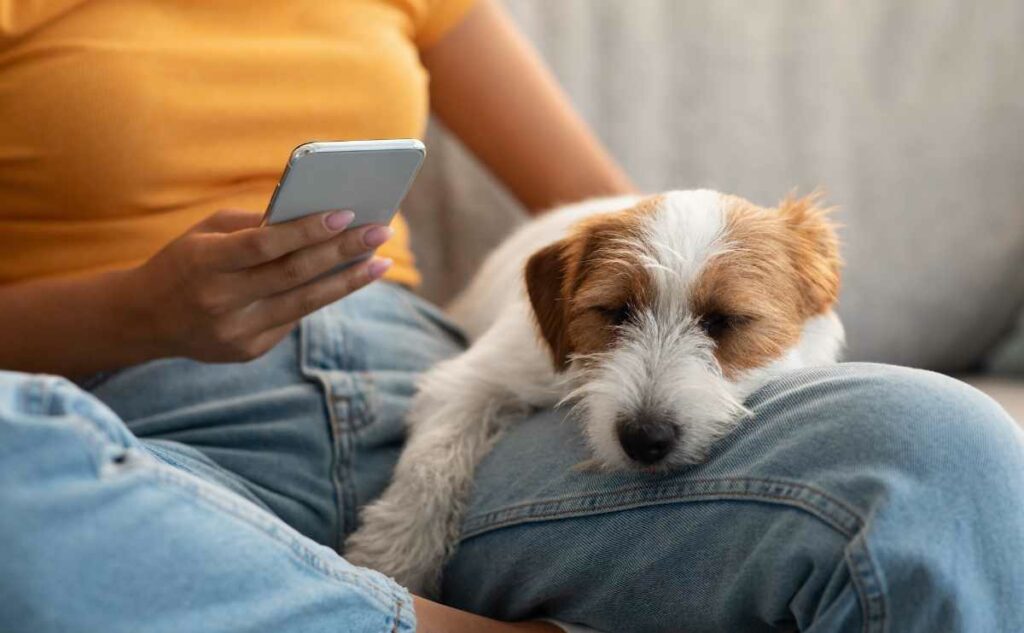
Understanding the Grief Timeline
There is no map for navigation when discovering how to handle a dog’s death. You may feel numb today and shattered tomorrow. Anger may come in waves. Guilt will whisper what-ifs in the dark.
You might cycle through them again and again:
- Shock and denial: “This can’t be real.”
- Anger or guilt: “Why didn’t I see the signs sooner?”
- Bargaining: “If only I had done one more thing…”
- Depression: The long, quiet heaviness that makes even getting out of bed feel impossible.
- Acceptance: Not the absence of pain, but the slow understanding that love and loss now share the same space.
If you find yourself feeling numb, angry, or even laughing again sooner than you expected, that’s normal, too. Healing isn’t a straight line; it’s a circle you’ll walk until the sharp edges soften.
When It Might Be Time for Help
Knowing how to deal with the death of your dog doesn’t mean you have to do it alone. Sometimes, professional support is what the heart truly needs. Pet loss grief is real and deserving of care.
If weeks have passed and you still can’t sleep, eat, or get through the day without breaking down, you may be dealing with complicated grief. This isn’t failure, it’s trauma that needs care.
Contact a licensed counselor or explore therapy through organizations like the American Psychological Association (APA), which can help you navigate that storm safely.
Here are a few trusted places that also offer online grief resources and literature:
- Association for Pet Loss and Bereavement
Certified grief counselors, chat rooms, and virtual group meetings - American Psychological Association
Evidence-based guides for coping with loss - Lap of Love Veterinary Hospice
Resources for end-of-life care and understanding euthanasia with compassion
7 Tiny Things That Actually Help When Grief Feels Too Big
When grief feels endless, the smallest things can make the biggest difference. You don’t have to rebuild your life right now; you just have to find air pockets inside the pain.
Here are seven small, real things that actually help:
- Step outside once a day. Sunlight resets your body clock and helps lower stress hormones that spike during grief.
- Create a small daily ritual. Light a candle, whisper their name, or play a song that reminds you of them. Grief softens through repetition.
- Write them a letter. Say everything you didn’t get to say. End with gratitude – it rewires your memory from trauma to love.
- Touch something that reminds you of them. Their blanket, collar, or a photo. Physical connection helps the brain process loss.
- Talk about them. Don’t push the memories away. Sharing their story helps keep their presence gentle instead of painful.
- Eat something nourishing. Grief burns through energy. Even a bowl of soup or a slice of toast helps your body stabilize.
- Let yourself cry when it hits. Suppressing emotion extends suffering. Tears are your body’s built-in healing mechanism.
Each of these steps is tiny, but together, they form a rhythm that grief can move through. You don’t heal by forgetting; you heal by feeling on purpose.
When Your Kids & Other Pets Are Grieving Too
Grief doesn’t live in just one heart. When a dog dies, the whole home feels it. Children, partners, and even your other pets can sense that something has changed.
Helping a Child Grieve the Loss of a Dog
For many kids, this is their first real experience with death. They may not know what to call the sadness in their chest, so it comes out as anger, withdrawal, or confusion.
Be honest and gentle. Say something like, “Our dog died. That means their body stopped working, and they won’t be coming back.” Avoid phrases like “went to sleep”, as this can create fear or misunderstanding.
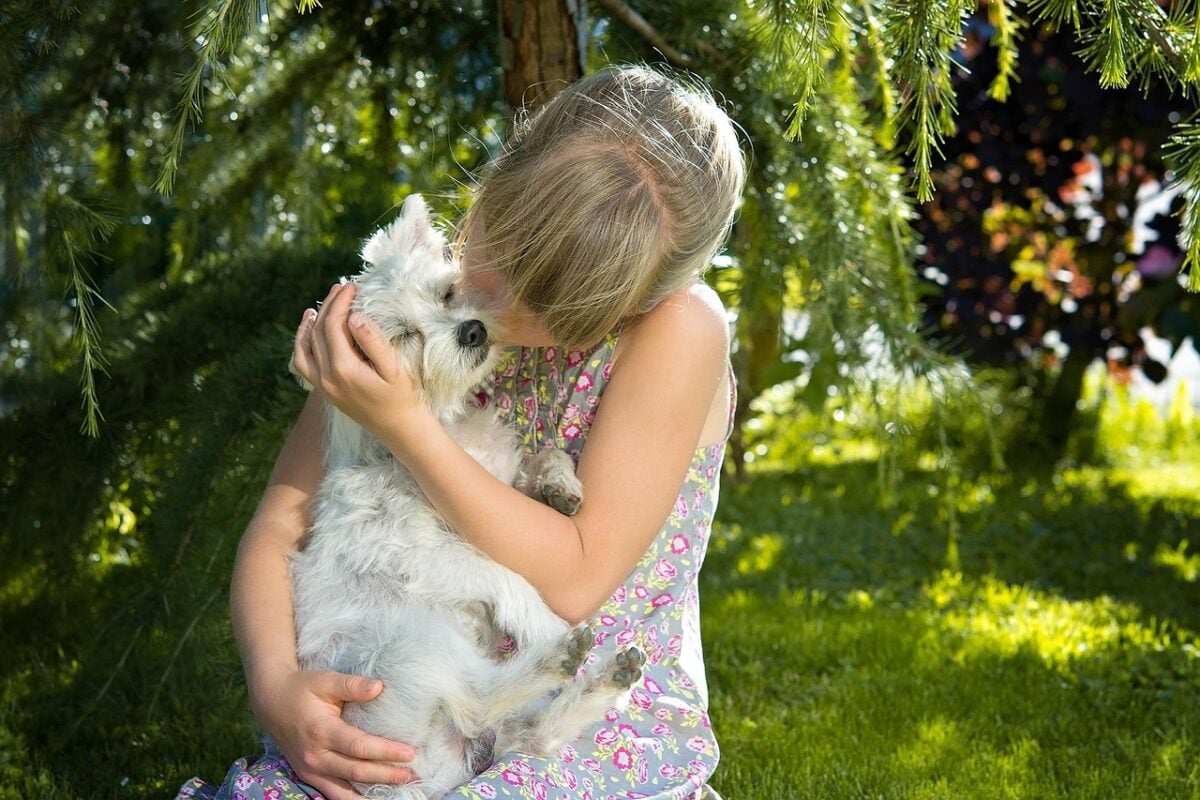
Give your child safe ways to express love and sadness:
- Draw a picture or make a card for your dog.
- Write a short “thank-you” letter or story about their favorite memory.
- Light a candle together or place a photo on the nightstand.
Let them see you cry, too. It teaches that sadness isn’t weakness, it’s love that doesn’t know where to go yet. And above all, listen. Let their stories spill out, even if they tell them repeatedly. Each one is a stitch in the fabric of healing.
Helping Another Pet Cope With Loss
Dogs and cats grieve, too. You might notice changes in appetite, pacing, howling, or sleeping patterns. They’re not “acting out”, they’re looking for their friend.
Keep routines as normal as possible: same feeding times, same walks, same bedtime rituals. Familiar rhythm gives comfort when the pack feels smaller. Your calm, steady presence is their anchor.
If your surviving pet searches the house or sniffs the old collar, let them. They’re processing in the only language they have, scent and memory. Offer extra closeness, gentle play, and patience.
Some pets may benefit from increased social stimulation, while others need solitude. Watch closely for signs of dog depression. Respect their needs as they arise.

If their distress lasts more than a few weeks or they stop eating altogether, speak with your vet. Sometimes, pets need help healing, too.
Do You or Your Dog Need More Guidance? We have a compassionate, more detailed guide exploring whether dogs understand death and how to navigate that journey.
A Personal Story: Remembering Bear
My dog Bear, a black Labrador, was the first dog I adopted as an adult. I had rescued many stray cats and dogs before then, but Bear was the first puppy I raised, just 10 weeks old when he came home. Bear was a kind-hearted soul. He grew up alongside my kids and quickly became an inseparable part of our pack.
When Bear was three, he was diagnosed with epilepsy. The vet gently asked if I wanted to consider euthanasia—it was a valid question, given how much work his care would require. But there was no question for me: Bear was family. We made the lifestyle changes, and in return, Bear gave us years of tail wags, mountain hikes, and the kind of snuggles that fix bad days.
In his senior years, Bear declined quickly. The seizures worsened. The meds stopped working. His spark faded. I knew it was time, even though I couldn’t imagine the house without him. I was afraid to broach the subject with my kids because I knew it would break their hearts, but both the vet and I knew it was time.
We spent his final days showering him in love, treats, and soft goodbyes. I stayed with him at the vet until after he passed, reassuring him to the end that he was a very good boy.
After he passed, we made plaster paw prints and cremated him. His ashes sit in an ornate wooden box beside the others we’ve lost. The grief came in waves, raw at first, then tender.
I leaned on our other two dogs, who grieved too in their quiet way. Bear left behind a thousand memories and a piece of my heart. Some dogs leave paw prints on your soul. Bear was one of them.
– Danielle DeGroot, Rescue Dog Mom, Canine Journal Research & Writing
Signs Your Dog Might Be Visiting You (And Why That Brings Comfort)
Even after goodbye, many dog parents say they still feel their pet nearby, a sound in the hallway, the jingle of a collar, a dream that feels too vivid to be random.
Whether you believe in spiritual connection or simply the strength of memory, these moments often bring unexpected peace.
Grief researchers call them “continuing bonds.” It’s the idea that our connection with those we love doesn’t end with physical loss; it changes form. But even if science explains it, that doesn’t make it less real. Love leaves traces, scents, routines, sensations, and those echoes are part of how we heal.
Many owners describe feeling their dog’s presence in quiet, everyday ways:
- The faint click of nails on hardwood when the house is still.
- A familiar whiff of their fur or shampoo out of nowhere.
- Dreams where they appear healthy and happy, just watching over you.
- The instinct to say their name, and somehow, it brings calm.
Whether you call it memory, spirit, or just the heart reaching back, these moments matter. They remind you that love doesn’t vanish, it lingers, softly, right where it was always strongest.
What Not to Say to Someone Who’s Lost a Dog (And What to Say Instead)
If you’ve ever lost a dog, you know how easily well-meaning words can sting. People don’t mean to be careless; they just don’t realize how deep the bond goes.
Here are a few things grieving pet parents often hear… and what they wish people said instead:
| ❌ What Not to Say | ✅ What Helps Instead |
|---|---|
| “It was just a dog.” | “They were family. I know how much you loved them.” |
| “You can always get another one.” | “No other dog could ever replace them, but one day, you’ll know when your heart’s ready again.” |
| “At least they’re not suffering anymore.” | “That must’ve been such a hard decision. You gave them peace.” |
| “Time heals everything.” | “Take all the time you need. I’m here to listen whenever you want to talk.” |
| “Don’t cry, they wouldn’t want you sad.” | “They brought you so much joy. It’s okay to cry for the love that was that big.” |
If you’re the one grieving, you can share this table with friends or family who are trying to help. It’s not about making anyone feel guilty; it’s about helping them understand that this isn’t “pet loss.” It’s heart loss.
And if you’re supporting someone else, remember: silence and presence often mean more than perfect words. Just showing up is enough.
Quick Takeaway: You can’t fix grief with words, but the right ones can make it softer. Lead with love, not advice.
7 Ways To Remember Them (That Actually Help You Heal)
Remembering your dog doesn’t have to reopen the wound; it can slowly turn grief into gratitude. These small rituals help keep their love alive in a way that feels peaceful, not painful.
According to a review of grief interventions published in Frontiers in Psychiatry, personal rituals significantly reduce prolonged grief. So, create one that speaks to you.
Here are seven ways to honor your dog’s memory while helping yourself heal:
- Create a photo book or digital album. Add your favorite pictures and little captions about each memory. It turns heartbreak into storytelling.
- Frame their collar, tag, or paw print. Every time you walk by, it reminds you that your love mattered.
- Volunteer at a local shelter. Helping another dog in need honors the one who taught you how to love in the first place.
- Plant a tree or flowers in their name. Watch something beautiful grow where your grief once sat.
- Get creative. Write a poem, paint a portrait, get a cremation tattoo, or make a playlist that sounds like them—joyful, loyal, full of life.
- Scatter their ashes somewhere special. A favorite trail, park, or beach where they were happiest.
- Mark their anniversary with kindness. Donate a toy or a bag of food to a rescue on the day they passed.
Each act of remembrance is another step toward peace. You’re not letting go; you’re learning how to carry them differently.
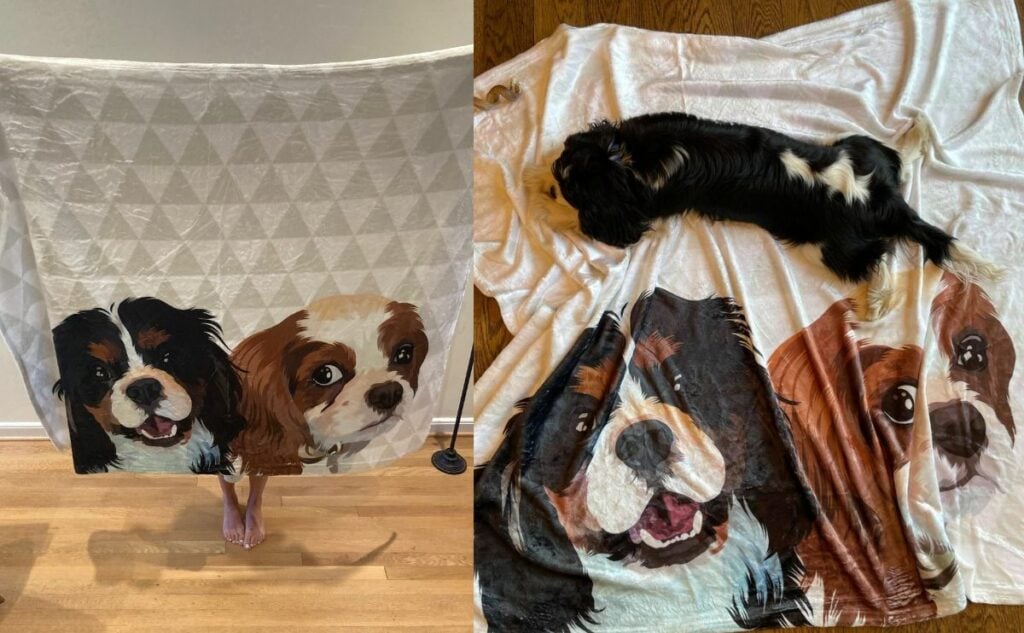
One of our team members had a fleece blanket made with her late dog Lexie’s face printed on it. Her other dog, Georgie, loves to curl up against it. Somehow, finding comfort in the familiar image, as if he understands it’s a soft way to stay close.
Quick Takeaway: The best memorial is a life that keeps loving. Every act of kindness in their honor keeps their spirit moving through the world.
Should You Get Another Dog? (The Honest Talk)
It’s the question that sneaks in once the house gets too quiet: Should I get another dog?
There’s no right timeline, only the one your heart can handle. Some people know within weeks that they need a new rhythm in the house. Others take months, even years, before the thought even feels possible. Both are perfectly okay.
Here’s the truth: bringing home another dog doesn’t replace love. It recycles it. You’re not betraying Lexie or Bear or whoever you’ve lost; you’re extending the love they taught you to give.
Ask yourself gently:
- Am I craving companionship or trying to fill the silence?
- Can I welcome a new dog without comparing them to the one I lost?
- Do I have the energy, time, and emotional room to bond again?
If you can say yes, your heart may be ready to open its door again. And if you’re not there yet, that’s okay, too. When the next one comes, you’ll feel the small spark of joy when you see a wagging tail, and your heart doesn’t ache; it softens.
You Loved Them Well & That’s Enough
In the end, your dog’s story is not written in the moment they left, but in the thousand days they were by your side. The walks. The greetings. The naps in the sun. That joy was real. That bond was deep. And that love? It doesn’t end here.
Grief is the echo of love. And if it hurts this much, it means you did it right. Learning how to deal with the death of your dog is not about forgetting; it’s about honoring what was beautiful.
So cry, remember, and heal. You loved them well. And that’s enough.
If You’re Not Ready to Say Goodbye Yet…
If you’re still holding on and trying to make the most of your time together, that’s okay. Not every story ends today. If you’re caring for an older dog, we’ve put together a few gentle guides to help you keep them comfortable and loved through every stage.
Explore our Senior Dog Care Guide for practical tips and check out our list of the Best Dog Foods for Senior Dogs to support their health. Read How to Show Your Dog You Love Them along with How Dogs Show They Love You, because sometimes, the smallest gestures mean the most.
Share Your Story With Us. Have you said goodbye to a beloved dog? What helped you heal, or what are you still holding? Share your story below. We read every comment, and you’re not alone.
